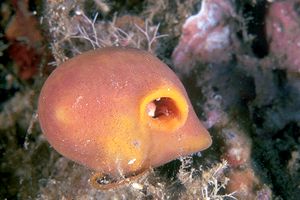
The Houtman Abrolhos is a chain of 122 islands and associated coral reefs, in the Indian Ocean off the west coast of Australia, about 80 kilometres (50 mi) west of Geraldton, Western Australia. It is the southernmost true coral reef in the Indian Ocean, and one of the highest latitude reef systems in the world. It is one of the world's most important seabird breeding sites, and is the centre of Western Australia's largest single-species fishery, the western rock lobster fishery. It has a small seasonal population of fishermen, and a limited number of tourists are permitted for day trips, but most of the land area is off limits as conservation habitat. It is well known as the site of numerous shipwrecks, the most famous being two Dutch ships: Batavia, which was wrecked in 1629, and Zeewijk, wrecked in 1727.
Dame Patricia Rose Bergquist was a New Zealand zoologist who specialised in anatomy and taxonomy. At the time of her death, she was professor emerita of zoology and honorary professor of anatomy with radiology at the University of Auckland.

The Western Bass Strait Shelf Transition is a biogeographic region of Australia's coastal and continental shelf waters. It is a transitional region between the cold-temperate Bass Strait Shelf and Tasmanian Shelf provinces and the warm-temperate Spencer Gulf Shelf Province. It is a provincial bioregion in the Integrated Marine and Coastal Regionalisation of Australia (IMCRA) system. It is the southern portion of the Western Bassian marine ecoregion in the World Wildlife Fund's (WWF) Marine Ecoregions of the World system.

Ceratosoma brevicaudatum, the short-tailed ceratosoma, is a species of colourful dorid nudibranch, a sea slug, a shell-less marine gastropod mollusk in the family Chromodorididae.

Suberitidae is a family of sea sponges belonging to the order Suberitida.

Plakoridine A is an alkaloid isolated from the marine sponge Plakortis sp. There are three plakoridines known, named plakoridine A, B, and C.
Ernstilla is a genus of sea sponges and is the only genus in the monotypic family Ernstillidae. It is represented by a single species Ernstilla lacunosa.

Temperate Australasia is a biogeographic region of the Earth's seas, comprising the temperate and subtropical waters of Australia and New Zealand, including both the Indian Ocean and Pacific coasts of the continent and adjacent islands.
Guilherme Muricy is a Brazilian invertebrate zoologist, and Professor of Invertebrate Zoology at the National Museum of Brazil. He is a specialist in sponges and has written over 100 papers on the chemistry, the taxonomy of sponges, and the descriptions of many new sponge species.
Plakortis fromontae is a species of marine sponge in the order Homosclerophorida, first described in 2011 by Guilherme Muricy. The species epithet, fromontae, honours Jane Fromont.
Corticium furcatum is a species of sponge in the order Homosclerophorida. It was first described in 2021, from a fragmented specimen collected at a depth of 5-7 m on the Booker Rocks in Jurien Bay.
Amphidiscella hosiei is a species of glass sponge in the family Euplectellidae, first found in the Perth Canyon at a depth of 695 m, off the Western Australian coast.
Amphimedon lamellata is a species of sponge in the family Niphatidae, first described by Jane Fromont in 1993, from a specimen collected at a depth of 9 m, from Macgillivray Reef, Lizard Island in the Great Barrier Reef.
Amphimedon paraviridis is a species of sponge in the family Niphatidae, first described by Jane Fromont in 1993, from a specimen collected at a depth of 7 m, in Geoffrey Bay, Magnetic Island, in the Great Barrier Reef.
Manihinea lynbeazleyae is a genus of deep-water sea sponge in the Theonellidae family, first described by Jane Fromont and Andrzej Pisera in 2011, from a specimen collected in the Perth canyon west of Rottnest Island at a depth of 194–232 m.
Caulospongia amplexa is a species of sea sponge belonging to the family Suberitidae.
Haliclona djeedara is a demosponge, first described by Jane Fromont and David Abdo in 2014. The species epithet, djeedara, means "brown" in Nyoongar.
Phyllis Jane Fromont is a New Zealand and Australian scientist specialising in sponges.
Pipestela terpenensis is a species of sponge belonging to the family Axinellidae.
Xestospongia bergquistia is a species of barrel sponge in the family Petrosiidae first described by Jane Fromont in 1991. The species epithet, bergquistia, honours the New Zealand sponge specialist, Patricia Bergquist.






